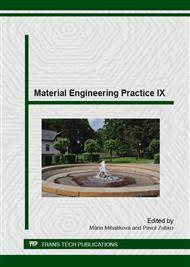p.26
p.30
p.35
p.41
p.45
p.51
p.57
p.61
p.66
Fluidity Test of Al-Si Alloy Using by Computer Simulation
Abstract:
Fluidity is the basic foundry property. The fluidity of AlSi alloy in real condition with computer simulation were compared. In this test was used two types of molds: horizontal molds with tree canals and vertical molds with six canals wich had different diameter (4,5; 6,5; 8,5; 10,5; 12 and 14 mm). As experimental material was used AlSi10MgMn (EN 1706) alloy. Range of pouring temperature was between 605°C to 830°C. NovaFlow&Solid soft commercial software package was used for numerically simulating the fluid flow of molten metal. The model of fluidity test was created by CAD system CATIA V5 R19. Measurement systems analysis (MSA), the analysis of the variance (ANOVA), t-test and the analysis of correlation were used for the evaluation. Youden plot was used for evaluation of the impact of operators on the errors. Values of fluidity for each temperature level obtained by the horizontal mold have a high degree of agreement with those obtained by computer simulation. On the contrary, the values, obtained by the vertical mold are more sensitive to the operator. This fact caused the match between the simulation and a practical experiment is only partial.
Info:
Periodical:
Pages:
45-50
Citation:
Online since:
December 2014
Authors:
Keywords:
Price:
Сopyright:
© 2015 Trans Tech Publications Ltd. All Rights Reserved
Share:
Citation:


